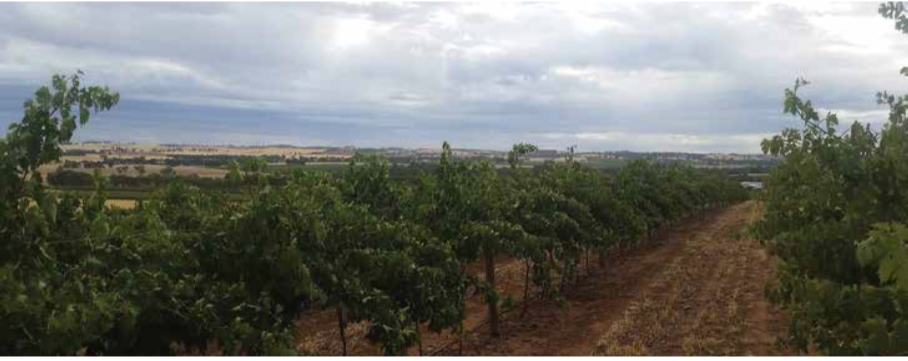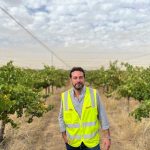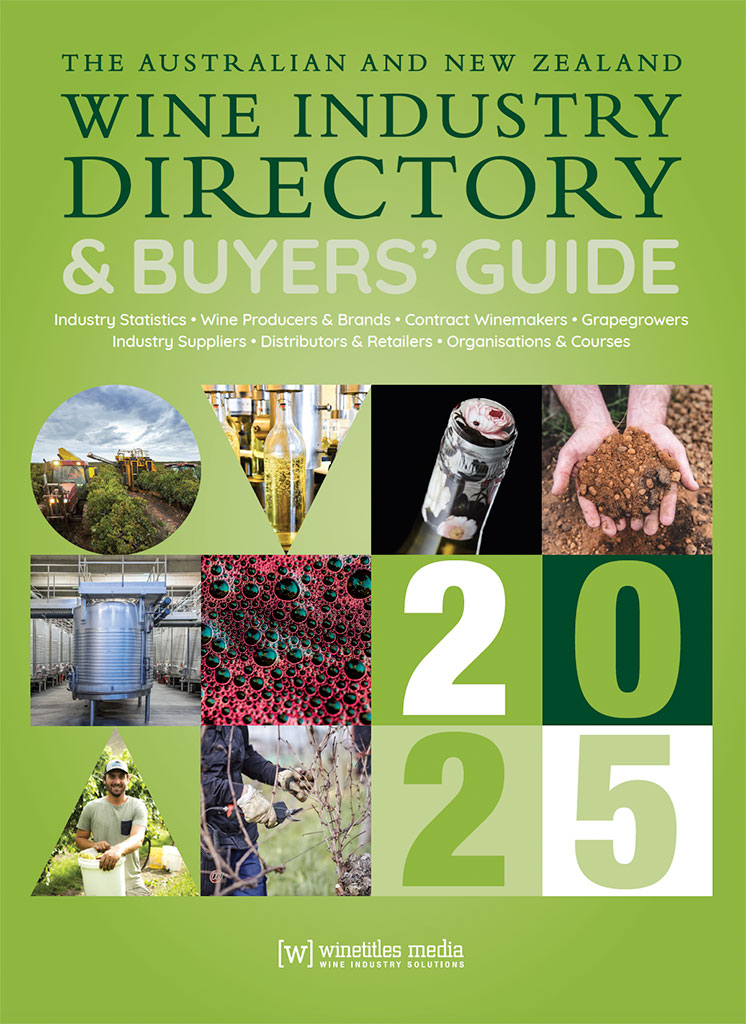By Andrew Kalleske, Director, Atze’s Corner Wines, Barossa Valley, South Australia
First published in the May/June 2016 issue of the Wine & Viticulture Journal

 Over the years we have searched for alternate varieties that are well suited to our warm Mediterranean climate and ancient red clay soils. Petit Verdot, Tempranillo, Negro Amaro, Graciano, Durif, Aglianico and Vermentino are a few we have considered.
Over the years we have searched for alternate varieties that are well suited to our warm Mediterranean climate and ancient red clay soils. Petit Verdot, Tempranillo, Negro Amaro, Graciano, Durif, Aglianico and Vermentino are a few we have considered.
One variety that came up on our radar in 2004 was the Italian variety Montepluciano, after a discussion with a local Italian winemaker who spoke highly of the wines made in Italy.
After further investigation it was clear to us that Montepulciano would be a variety that would be well worth growing, considering the shallow topsoils and deep red clays of the Koonunga sub-region of the Barossa Valley.
The site we chose sat high on one of the highest hills in the area (300m above sea level), has an east-facing slope and ironstone scattered over the surface of an ancient 200 million-year-old landscape.
These perfect conditions restrict Montepulciano’s natural tendency for high yields and also keep the berry size small for increased concentration of flavour; they also suit the variety’s other natural tendency for dark colour and ripe tannins.
To replicate the vineyards grown in Italy we decided to plant at a higher vine density than we otherwise would for mainstream varieties such as Shiraz, Grenache and Cabernet Sauvignon.
Planting to a one-metre vine spacing and 3.6m row width may not be as close as can be found in Italy but this row width suits the machinery we use on our property. However, the one metre gap between the vines gives us extra density – an increase from our normal 1300 vines per hectare to 2600 vines per hectare. The aim of this is to increase competition among the vines for available moisture, increasing the intensity of flavours and tannins, while maintaining a reasonable yield and keeping the vineyard competitive from a profit standpoint compared with its mainstream rivals where the prices paid per tonne can be as much as 100% higher. With a single wire permanent arm and catch wire 200mm above the cordon to prevent rolling, this provides sufficient leaf shading with dappled sunlight for the fruit in summer.
If the returns on Montepulciano can be much lower, why did we plant it in the first place?
While there isn’t one straight answer to this question, I’ll outline a couple of reasons why before considering the most important one.
There was an oversupply of Shiraz and other mainstream varieties in the Barossa after excessive plantings following the grape boom of the 1990s. Subsequently, there was a call out for small amounts of alternative varieties to fill some gaps to create extra interest in what else the Barossa can produce, making wine with unique varietal characters different to those offered by the mainstream varieties of Shiraz and Cabernet Sauvignon.
On top of this, there was also a desire to spread out the harvest season so we were not pressed to pick everything at the same time, with Montepulciano ripening well after Shiraz.
The one reason that wasn’t particularly obvious at the time we decided to plant the Montepulciano but is becoming increasingly important concerns that fact that the seasons are becoming warmer, which brings to the fore the variety’s ability to handle warmer summers and ripening periods. Varieties whose homes are found in hot regions like mid-southern Italy and Spain, in my opinion, will become more mainstream as they’ll become more consistent performers in the long term both from a yield (less shrivel compared with Shiraz) and quality point of view.
The early days of our patch of Montepluciano were a little hairy (or woolly in this case!) In late November 2011, the vines had a very healthy start and were showing their first crop of grpaes. As fate would have it a mob of 150 sheep that were grazing in a paddock next door found a small one-foot-wide gap in the fence and charged through, stripping the vines bare as they thought all their Christmases had come at once.
After retraining the vines all over again we harvest the first crop in 2014. While the vines didn’t look completely balanced yet, the bunches were loose and the canopies had a healthy dark jungle green colour. A light shoot thin in mid-October prior to harvest helped the vines maintain good balance and good fruit-to-leaf ratio.
Montepulciano is a late-ripening variety and we harvest two weeks after our Shiraz harvest has ended. Even with this lateness of harvest the grapes hold their acidity beautifully. We picked it at a pH of 3.5 and a modest (for us) 14°Baume.
We fermented the grapes in a single fermenter without putting it through the destemmer, maintaining whole berries for carbonic maceration in the ferment.
As it was picked late in the season we had nice cool ambient temperatures for fermentation, allowing us to slowly ferment naturally for eight days. Hand plunging and short manual pumpovers kept the berries nice and whole through the ferment and gave us a beautiful bring purple hue and alluring blue and black fruit characters.
Following the ferment we basket pressed and transferred the wine into third-fill French oak hogshead barrels, tasting the wine every three months to monitor the wine’s slightly aggressive raw tannins.
These tannins were the most interesting aspect to us in the early days of maturation – ripe, yet very raw for their first 12 months to a point we weren’t really sure if we’d have a place for it in our Atze’s Corner line up. After about 12 months we noticed the tannins softening, complementing the lovely rich blackberry, prune and cocoa flavours and bright natural acidity that Montepulciano is famous for.
The fruit continues to show these same qualities as the balance of the vineyard improves with each vintage. And the carefully monitored fencing now ensures that no woolly jumbucks will spoil the party in the future.
In my opinion, Montepulciano, from a viticultural standpoint, is the most suited alternate red variety we have experiment with to date, standing alongside Vermentino, our preferred white variety for the Barossa’s climate.
Should you take my word for it? It’s still early days but such a young vineyard performing the way it is, with multiple gold medals from its first vintage, can only promise good things for its future.
I have a feeling it’s here to stay and its matching ability with cuisine like roast beef and pork, spaghetti bolognaise and meat lover’s pizza will make it a big hit with a wide variety of food choices.
Montepulciano

By Peter Dry, Emeritus Fellow, The Australian Wine Research Institute
Background
Montepulciano (MON-tay-pull-CHAH-noh) is most likely of Italian origin—not Greek as claimed in some references. It has been confused with Sangiovese, perhaps because its name is the same as the hilltop town in Tuscany known for the wine DOCG Vino Nobile di Montepulciano made from Sangiovese (syn. Prugnolo Gentile). DNA analysis has revealed that Montepulciano is not related to Sangiovese. Synonyms include Cordisco, Cordisio, Morellone, Premutico, Primaticcio, Primitivo, Primutico, Sangiovese Cordisco, Sangovetto, Torre di Passeri and Uva Abruzzese. Globally there were 34947 ha in 2010 (up 22% from 2000), close to 100% in Italy. It is mainly grown in the central regions and makes up 55% of the planted area of Abruzzo, 49% of Molise and 19% of Marche. Montepulciano is the main variety in Marche DOCs such as Rosso Conero (minimum 85%), Rosso Piceno (minimum 35-70%) and also used in several DOCs in Molise and Puglia. Outside of Italy, there are just tiny areas in Argentina, Brazil, USA and New Zealand. There are now more than 46 wine producers in Australia, from hot to cool regions, and mainly in SA. In 2015, there were 74 ha in Australia (41 ha in SA).
Viticulture
Budburst and maturity are late. The medium bunches are compact to well-filled. The medium berries have a thick skin. It is vigorous with semi-erect growth habit. Yield is moderate to high depending on clone. Montepulciano has a tendency to overcrop which may necessitate bunch thinning. In Australia it has proved to be both drought and heat tolerant and withstands prolonged heat waves much better than any mainstream variety. In Italy, it is both spur- and cane-pruned but spur is most common in Australia. It has good tolerance of both Botrytis bunch rot and downy mildew but it is sensitive to powdery mildew.
Wine
Montepulciano is used for different wine styles from rose to full bodied reds. Wines are well-coloured and full-bodied with rich flavours and robust tannins, and age well. Descriptors include blackberry, cherry, mulberry, plum and earthiness. It is useful in blends with softer varieties.




















